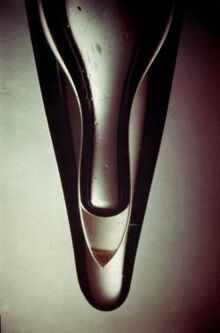Chemistry:Americium(III) hydroxide

| |
| Names | |
|---|---|
| IUPAC name
Americium(III) hydroxide
| |
| Systematic IUPAC name
Americium(3+) trihydroxide | |
| Other names
Americium hydroxide
Americium trihydroxide | |
| Identifiers | |
3D model (JSmol)
|
|
| ChemSpider | |
PubChem CID
|
|
CompTox Dashboard (EPA)
|
|
| |
| |
| Properties | |
| Am(OH) 3 | |
| Molar mass | 294.084 g/mol |
| Hazards | |
| Main hazards | Radiation |
| NFPA 704 (fire diamond) | |
| Related compounds | |
Other anions
|
Americium(III) oxide Americium(III) chloride Americium(III) bromide |
Other cations
|
Curium(III) hydroxide Europium(III) hydroxide |
Except where otherwise noted, data are given for materials in their standard state (at 25 °C [77 °F], 100 kPa). | |
| Infobox references | |
Americium(III) hydroxide is a radioactive inorganic compound with the chemical formula Am(OH)
3. It consists of one americium atom and three hydroxy groups. It was first discovered in 1944, closely related to the Manhattan Project. However, these results were confidential and were only released to the public in 1945. It was the first isolated sample of an americium compound, and the first americium compound discovered.
Properties
Americium hydroxide is a pink solid[1] which is sparingly soluble in water.[2]
Due to self-irradiation, the crystal structure of 241
Am(OH)
3 decomposes within 4 to 6 months (241
Am has a half-life of 432.2 years); for 244
Cm(OH)
3 the same process takes one day (244
Cm has a half-life of 18.11 years).[1]
Synthesis
Americium metal can be converted to Am(OH)
3 in a four-step process. As described by the Oak Ridge National Laboratory, americium is added to hydrochloric acid, then neutralized using ammonium hydroxide (NH
4OH). A saturated oxalic acid solution is added to the now neutralized solution. This causes large americium oxalate crystals to begin to grow. Once complete precipitation is achieved, oxalic acid is once again added, to attain a slurry of americium oxalate and oxalic acid. The americium oxalate is then filtered out, washed with water, and is partially dried by allowing exposure to air.
- Am + (COOH)
2 → Am(COO)
2
The americium oxalate is then added to a platinum combustion boat to undergo calcination. The americium oxalate is dried in a furnace and will begin to decompose at 350 °C. When decomposition begins to occur, the oxalate will turn into the desired black americium dioxide. To ensure no oxalate remains in the americium dioxide, the oven temperature is increased to and held at 800 °C and then slowly allowed to cool to room temperature.
- Am(COO)
2 → AmO
2
The americium dioxide is heated again, to about 600 °C, in the presence of hydrogen, to produce americium(III) oxide.
- 2AmO
2 + H
2O → Am
2O
3 + O
2 + H
2
The final step involves the hydrolysis of the americium(III) oxide, to produce the final product, americium(III) hydroxide.[3]
- Am
2O
3 + 3H
2O → 2Am(OH)
3
Reactions
When ozone is bubbled through a slurry of americium(III) hydroxide in 0.03 M potassium bicarbonate at 92 °C, hexagonal KAmO
2CO
3 (potassium dioxoamericium(V) carbonate) can be obtained. Potassium carbonate can also be used. The resulting KAmO
2CO
3 reacts with dilute acids to produce americium dioxide.[4]
- O
3 + Am(OH)
3 + KHCO
3 + H
2O → KAmO
2CO
3 + 3H
2O + O
2
In a dilute base such as sodium hypochlorite, Am(OH)
3 gets oxidised to Am(OH)
4, which is black in solution. Further oxidation using ozone and sodium hydroxide can produce yellow hydroxy species of Am(VI).
See also
References
- ↑ 1.0 1.1 Krivovichev, Sergey; Burns, Peter; Tananaev, Ivan (2006). Structural Chemistry of Inorganic Actinide Compounds. Elsevier. p. 67. ISBN 978-0-08-046791-7. https://books.google.com/books?id=mV-phntexBQC&pg=PA67.
- ↑ Runde, Wolfgang (2011) (in en), Americium and Curium: Radionuclides, American Cancer Society, doi:10.1002/9781119951438.eibc0438, ISBN 978-1-119-95143-8, https://onlinelibrary.wiley.com/doi/abs/10.1002/9781119951438.eibc0438, retrieved 2020-03-21
- ↑ Morss, L. R.; Williams, C. W. (1993-12-31). "Synthesis of crystalline americium hydroxide, Am(OH)3, and determination of its enthalpy of formation; estimation of the solubility-product constants of actinide(III) hydroxides". https://digital.library.unt.edu/ark:/67531/metadc1273080/m1/7/.
- ↑ Template:Cite tech report
 |


